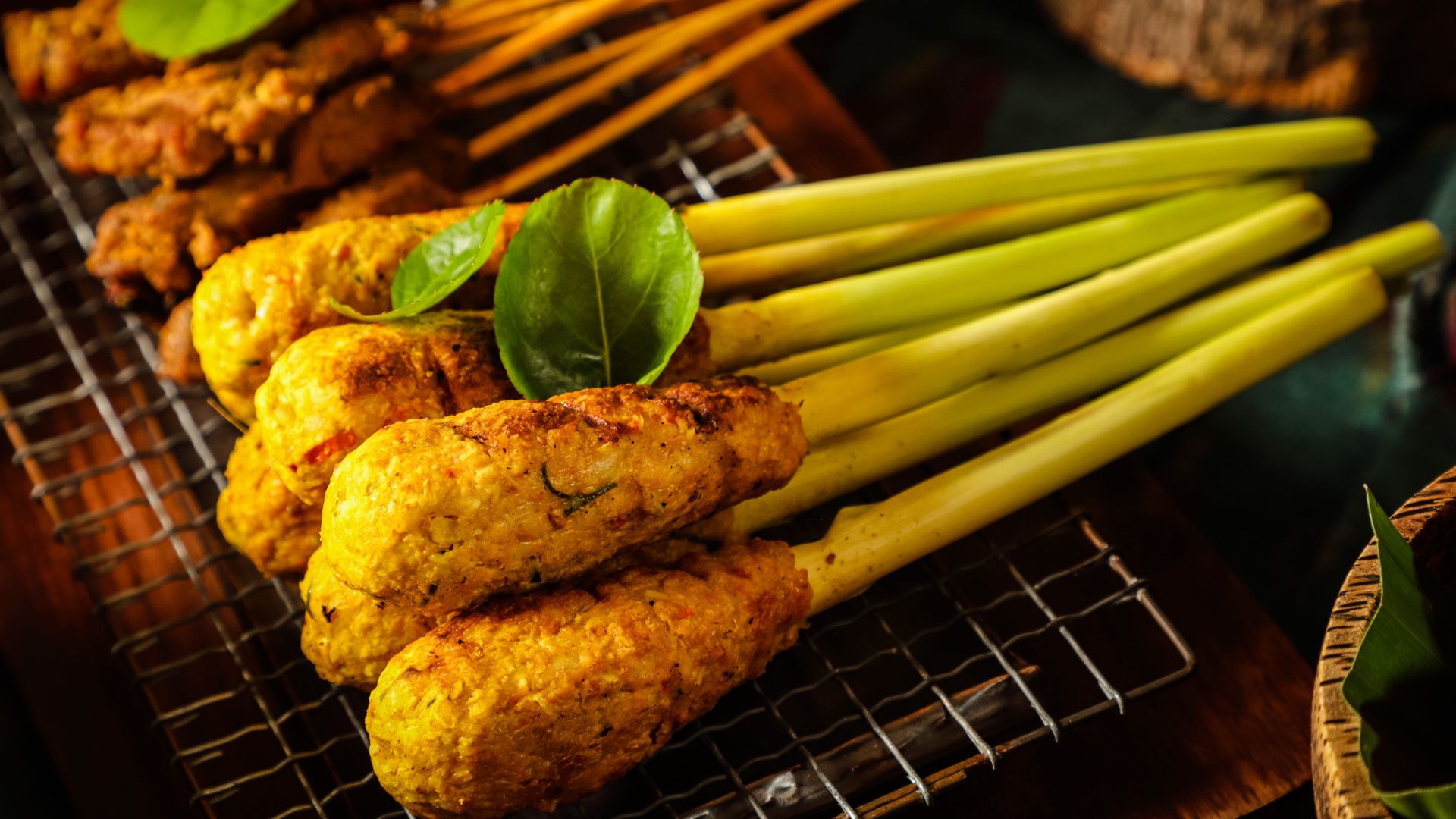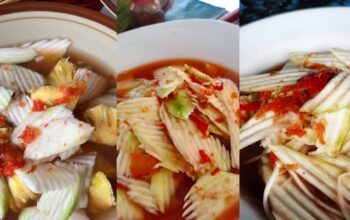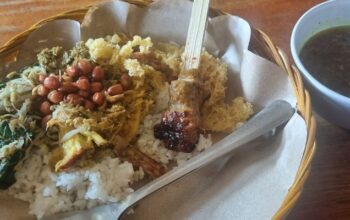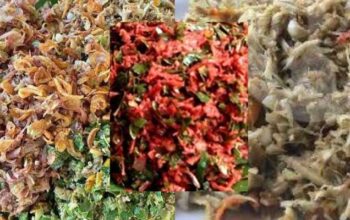Sate Lilit: A Culinary Gem from Bali
If you’ve ever traveled to Bali, you’ve likely heard of Sate Lilit. This particular sate stands apart from most others found elsewhere. From its preparation and ingredients to its flavor, everything about it possesses a unique quality that has captivated many with this signature Balinese dish. Typically, sate consists of meat skewered on wooden or bamboo sticks. However, Sate Lilit is made by wrapping the minced meat mixture around lemongrass stalks or flat bamboo skewers. This is where the name “lilit” (meaning “to wrap”) comes from – because the meat is wrapped, not skewered. This technique gives Sate Lilit its distinctive shape and a more fragrant aroma, especially when fresh lemongrass stalks are used.
Key Ingredients and Spices in Authentic Balinese Sate Lilit
One of the most distinctive aspects of Sate Lilit is its minced meat mixture. The choice of meat can be flexible, depending on personal preference and local traditions in certain areas of Bali. However, the following are generally the main ingredients:
Meat:
- Mackerel (Ikan Tenggiri) – This is the most commonly used due to its suitable texture and aroma, which pairs well with the spices.
- Chicken, Pork, or Beef – Some places in Bali also use these, depending on custom and preference.
Mixing Ingredients:
- Grated Coconut – Makes the mixture softer and more fragrant.
- Coconut Milk – Adds richness and creaminess, while keeping it tender.
- Egg – Helps bind the mixture together.
Ground Spices:
These are what give Sate Lilit its distinctive Balinese flavor:
- Shallots & Garlic
- Red Chili (for a spicy kick)
- Turmeric
- Galangal
- Ginger
- Lemongrass (often used as the skewer itself!)
- Lime Leaves
- Coriander
- Grilled Shrimp Paste (optional, but deepens the flavor)
- Salt, Sugar, and Pepper
All these spices are ground or blended until smooth, then mixed into the meat mixture.
How to Make Sate Lilit
- Finely Mince the MeatFirst, the meat is cut into small pieces, then minced until fine. It can also be blended, but not too finely, to retain some texture.
- Sauté the Ground SpicesThe ground spices are sautéed until fragrant. This step is crucial to bring out their maximum aroma and flavor.
- Mix All IngredientsAfter the spices are cooked and cooled, mix them into the minced meat. Add the grated coconut, coconut milk, egg, and other complementary seasonings. Mix well until it forms a sticky, moldable dough.
- Wrap onto SkewersTake a small amount of the mixture and wrap it around a skewer – usually a lemongrass stalk or flat bamboo skewer. Make sure it’s wrapped tightly so it doesn’t fall off during grilling.
- Grill Until CookedGrill over hot coals or a grill until the outside is browned and very fragrant. Don’t forget to turn it frequently to ensure even cooking.
Popular Types of Sate Lilit in Bali
Although the shape and preparation are almost identical (wrapped on skewers), the type of meat used can vary depending on the region, customs, and specific ceremonies. Here are some of the most commonly found:
- Fish Sate LilitThis is the most common and a favorite of many. It typically uses mackerel due to its soft and easily processed meat. It’s incredibly savory, especially when grilled over charcoal, giving it a superb aroma!
- Chicken Sate LilitFor those who don’t eat fish, chicken sate lilit can be an option. Its taste is lighter, but still features strong, authentic Balinese spices. It’s also suitable for children as it’s not fishy.
- Pork Sate LilitThis type is often found in local eateries and warungs in Bali. It has a richer flavor and a denser texture. However, not all places serve it due to religious or customary reasons.
- Beef Sate LilitSomewhat rarer, but still available. It’s usually prepared for large family gatherings or parties. It has a more substantial and rich flavor, perfect for those who enjoy red meat.
- Vegetarian Sate LilitFor those who don’t eat meat, many vegetarian versions are now available. These are typically made from tofu, tempeh, mushrooms, or even grated coconut. The taste remains delicious because the traditional Balinese spices are still used.
The Role of Sate Lilit in Balinese Culture and Tradition
For some, Sate Lilit might just be considered a delicious Balinese dish to enjoy during a holiday. But looking deeper, Sate Lilit actually holds strong cultural significance for the Balinese people. This food is not just about taste; it also plays an important role in the customary and spiritual life of the Balinese.
In Bali, food is not only for consumption but also for offerings to ancestors and deities. Sate Lilit is often prepared as part of “banten” or religious ceremonial offerings. In ceremonies like “odalan” (temple anniversary), Galungan, Kuningan, or Melasti, Sate Lilit is usually served alongside other dishes. Because it’s made from a mixture of various ingredients and spices, Sate Lilit is considered a symbol of abundance and unity.
Leading up to major holidays or events, residents of a “banjar” (community) or extended family will usually gather to cook together. The process of making Sate Lilit – from preparing spices and grinding meat to wrapping the mixture onto skewers – is done collaboratively, accompanied by conversation and laughter. This tradition strengthens the sense of togetherness and mutual cooperation, values that are deeply cherished in Balinese society. Thus, besides yielding delicious food, this process also becomes a moment to strengthen relationships among community members.
Conclusion
Sate Lilit is a unique Balinese culinary specialty, made from seasoned minced meat wrapped around lemongrass stalks or bamboo, rather than skewered like regular sate. Its taste is savory, its aroma fragrant, and its texture tender. There are various types – from fish, chicken, and pork to vegetarian – each with its own characteristics. More than just food, Sate Lilit also carries deep cultural significance, often appearing in traditional ceremonies and symbolizing Balinese community spirit. Therefore, Sate Lilit is not just about taste, but also a part of Balinese tradition and identity.












